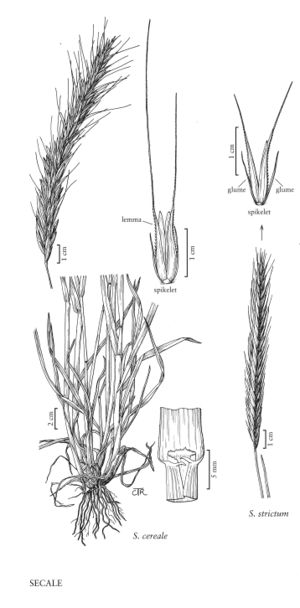Difference between revisions of "Secale strictum"
FNA>Volume Importer |
FNA>Volume Importer |
||
| Line 15: | Line 15: | ||
-->{{Treatment/Body | -->{{Treatment/Body | ||
| − | |discussion=<p>Secale strictum is native to Eurasia and, as a disjunct, to South Africa. It grows on dry, stony or sandy soils, often in mountainous areas. So far as is known, it is not established in the Flora region.</p><!-- | + | |discussion=<p><i>Secale strictum</i> is native to Eurasia and, as a disjunct, to South Africa. It grows on dry, stony or sandy soils, often in mountainous areas. So far as is known, it is not established in the Flora region.</p><!-- |
| − | --><p>Hitchcock (1951) reported that Secale strictum had become established around the Agricultural Experiment Station in Pullman, Washington, but it is no longer present there. Prior to 1931, the station worked on development of a S. cereale x S. strictum strain that would combine the perennial habit with good seed production. The attempt had been abandoned by 1931, but hybrid seed had been distributed as ‘Michael’s Grass’. The seed was originally thought to be derived from a Triticum aestivum x Leymus racemosus cross; subsequent studies, both morphological and cytological, revealed that it was S. cereal x S. strictum.</p> | + | --><p>Hitchcock (1951) reported that <i>Secale strictum</i> had become established around the Agricultural Experiment Station in Pullman, Washington, but it is no longer present there. Prior to 1931, the station worked on development of a <i>S. cereale</i> x <i>S. strictum</i> strain that would combine the perennial habit with good seed production. The attempt had been abandoned by 1931, but hybrid seed had been distributed as ‘Michael’s Grass’. The seed was originally thought to be derived from a <i>Triticum aestivum</i> x <i>Leymus racemosus</i> cross; subsequent studies, both morphological and cytological, revealed that it was S. cereal x <i>S. strictum</i>.</p> |
|tables= | |tables= | ||
|references= | |references= | ||
| Line 25: | Line 25: | ||
-->{{#Taxon: | -->{{#Taxon: | ||
name=Secale strictum | name=Secale strictum | ||
| − | |||
|authority=(C. Presl) C. Presl | |authority=(C. Presl) C. Presl | ||
|rank=species | |rank=species | ||
| Line 33: | Line 32: | ||
|family=Poaceae | |family=Poaceae | ||
|illustrator=Cindy Roché | |illustrator=Cindy Roché | ||
| + | |illustration copyright=Utah State University | ||
|reference=None | |reference=None | ||
|publication title= | |publication title= | ||
|publication year= | |publication year= | ||
|special status= | |special status= | ||
| − | |source xml=https:// | + | |source xml=https://jpend@bitbucket.org/aafc-mbb/fna-data-curation.git/src/f50eec43f223ca0e34566be0b046453a0960e173/coarse_grained_fna_xml/V24/V24_373.xml |
|subfamily=Poaceae subfam. Pooideae | |subfamily=Poaceae subfam. Pooideae | ||
|tribe=Poaceae tribe Triticeae | |tribe=Poaceae tribe Triticeae | ||
Revision as of 20:20, 16 December 2019
Plants perennial, short-lived; cespitose. Culms (35) 60-100(150) cm. Blades 2-8 mm wide, glabrous or scabridulous. Spikes (3.5)5-8(11) cm; disarticulation occurring readily, in the rachises, at the nodes. Glumes 8-11 mm, densely scabrous on the keels, acuminate or awned, awns 3-4 mm; lemmas 8-16 mm, awns 2-25 mm. 2n = 14.
Discussion
Secale strictum is native to Eurasia and, as a disjunct, to South Africa. It grows on dry, stony or sandy soils, often in mountainous areas. So far as is known, it is not established in the Flora region.
Hitchcock (1951) reported that Secale strictum had become established around the Agricultural Experiment Station in Pullman, Washington, but it is no longer present there. Prior to 1931, the station worked on development of a S. cereale x S. strictum strain that would combine the perennial habit with good seed production. The attempt had been abandoned by 1931, but hybrid seed had been distributed as ‘Michael’s Grass’. The seed was originally thought to be derived from a Triticum aestivum x Leymus racemosus cross; subsequent studies, both morphological and cytological, revealed that it was S. cereal x S. strictum.
Selected References
None.
